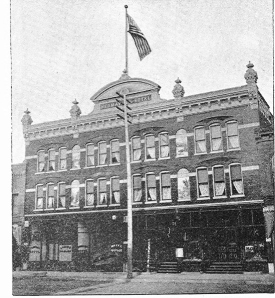228 Park Avenue – Jacob Neumayer
Jacob Neumayer was born in Baden-Wuerttemberg, Germany in 1843. He came to the United States in 1867and settled first in St. Louis. He arrived in Council Bluffs in 1871 and went to work for Conrad Geise, becoming manager of the Geise Brewery, a position he held until 1882.
Frances Baumeister was born in Neidenstein, Germany in 1852. She married Jacob Neumayer in 1873. Of their eight children, five died in infancy or early childhood. Their surviving children were Theresa, Lucas, and Louise.

Neumayer Hotel
In 1882, Neumayer purchased the Bryant House (hotel), which he remodeled at a cost of $5,000. By 1888 he found the hotel to be too small for the demand and built a three-story brick building on the adjoining property. The major part of the original hotel burned in 1897, and Neumayer replaced it with a three-story building, making the frontage uniform with iron and plate glass front. There were 75 rooms in the hotel, lighted with gas and electricity, and steam-heated. The rates were $1.00 to $1.50 per day. A brick barn behind the hotel afforded stable room for 150 horses. Street car lines from all depots passed the door. (From the Council Bluffs publication of the Trans-Mississippi Exposition of 1898 held in Omaha).
In 1887, the German-speaking members of St. Francis Xavier parish, which was predominantly Irish, decided they needed a parish and church of their own. This would keep their people together, preserve their culture and allow them to hear sermons in their own language. With the support of the Irish of St. Francis- which included brick makers and contractors James Wickham and Martin Hughes– fourteen German men led the effort to build the new church.
Jacob Neumayer was one of the fourteen. Ice cream socials and other fundraising events were held at the Neumayer Hotel. In addition to his initial major contribution, the Jacob Neumayer family donated the three bells, shipped up the river from St. Louis at a cost of $400. Names of members of his family are inscribed on the bells. The church was dedicated in 1887 and was served by German-speaking priests from the Benedictine Abbey at Atchison, Kansas. A convent and a two-classroom school were opened in adjacent houses by 1888. The rectory was built in 1895. The Abbey continued to provide pastors for the parish until 1975 when it became part of the Diocese of Des Moines. (From the archives of St. Peter church).

The Neumayer family home at 228 Park Avenue was built in 1903.The style of the house is listed as Neoclassical in the nomination of the Park/Glen Avenues Historic District nomination to the National Register of Historic Places. Features noted include: narrow wood-lapped siding, asphalt-shingled pyramidal-hipped roof with cross-gabled dormers on the roof slope. The one and one-half story squarish house has a hipped roof that flares at the wide eave overhang and features modillion blocks under the eaves of the house and porch. Front-gabled dormers feature cornice returns and an oval window above a triple row of windows. Classical details include the modillion blocks, the three-quarters height round porch posts with ornate capitals, and the faux Classical-columned cornerboards on the dormers. Porch posts are set on masonry piers, with turned balusters on the wood railing. The front door is centered and features side lights of leaded and beveled glass. Also of note is the canted corner and rounded bay window on the north side of the house.
Jacob and Frances Neumayer lived in the house until 1921 when their daughter Louise and her husband Tom Wack moved in. The Neumayers then moved into the house at 179 Glen Avenue, which they also built in 1903. Frances died in 1921, and Jacob continued to live there until his death in 1926. The Neumayers are buried in St. Joseph Cemetery.
Although no longer the German national church, St. Peter church still stands at One Bluff Street, overlooking downtown Council Bluffs. The church, with the connected rectory, is designated a local landmark, and is the only church in the city that is listed on the National Register of Historic Places.
Source Material
Preserve Council Bluffs acknowledges the following sources of information for this series: National Register of Historic Places nominations, the reference department of the Council Bluffs Public Library, the auditor’s office of the Pottawattamie County courthouse, Council Bluffs Community Development Department, homeowners, family members and individual research.

Preserve Council Bluffs is a non-profit organization whose mission is to promote and preserve the heritage of Council Bluffs through its architecture, sites, and people.
© 2021 Preserve Council Bluffs | All Rights Reserved
Learn More
